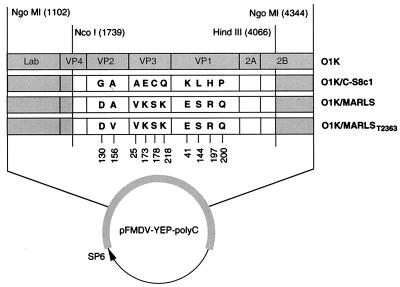FIG. 3.
Schematic representation of the capsid coding region of FMDV O1K and of C-S8c1 and its variant derivatives, as inserted in the parental type O1 plasmid pFMDV-YEP-poly(C) (60). Type C genomic regions are represented by open boxes. NgoMI restriction sites and their numbering refer to FMDV O1K cDNA (60). NcoI and Hind III sites and their numbering refer to the C-S8c1 genome (20). Amino acid residues differing in the compared chimeric genomes are indicated. The vertical numbers at the bottom refer to the corresponding positions in each protein. Infectious transcripts were produced with plasmid pFMDV-YEP-poly(C), and derived constructs encoding the cDNA of FMDV O1K or type O-type C chimeras under the control of the SP6 promoter. The amino acid sequence of protein VP4 is conserved among the FMDVs of serotypes O and C analyzed here. Procedures for the construction of chimeric viruses and confirmatory sequence analysis of chimeric progeny are described in Materials and Methods. O1K/MARLS includes a capsid-coding region identical to the consensus sequence of FMDV MARLS. T-2363 indicates an Ala-156 → Val mutation in protein VP2 that was accidentally selected during the cloning procedure. Infectious transcripts were produced with plasmid pFMDV-YEP-poly(C) and derived constructs encoding the cDNA of FMDV O1K or type O-type C chimeras under the control of the SP6 promoter. The amino acid sequence of protein VP4 is conserved among the FMDVs of serotypes O and C analyzed here. Procedures for the construction of chimeric viruses and confirmatory sequence analysis of chimeric progeny are described in Materials and Methods.

